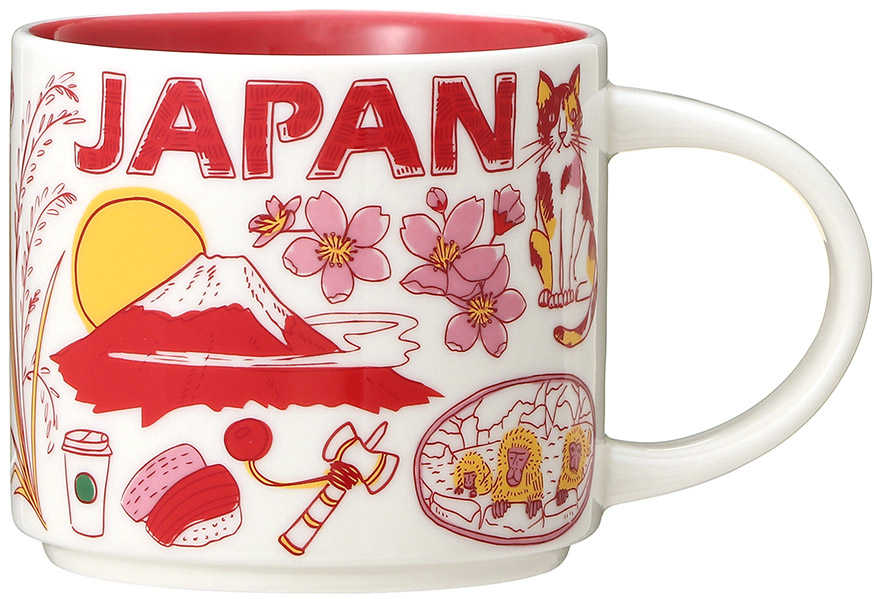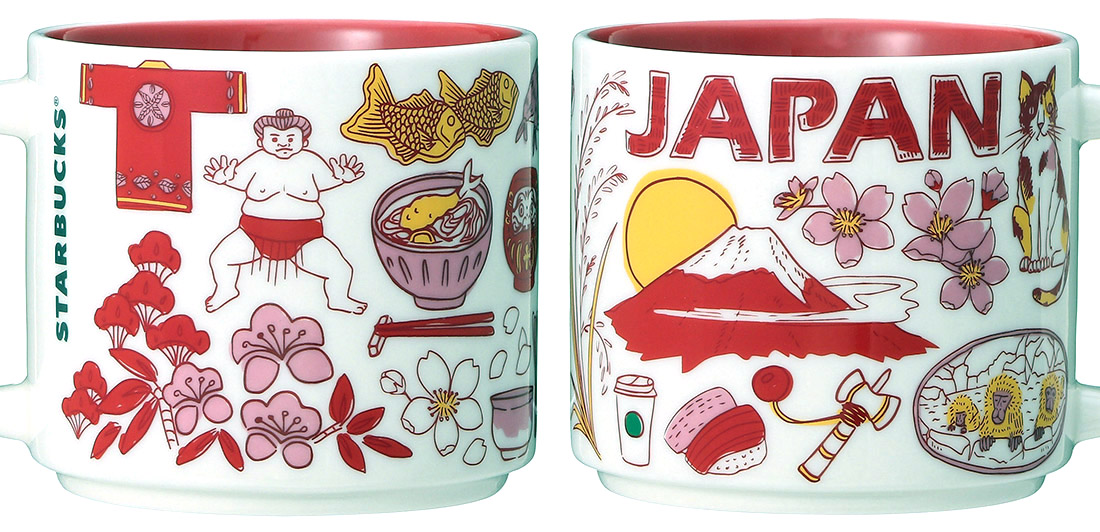
Been There – Japan
It has been a while since the release of the Starbucks Been There – Japan mug, and I have no excuse for not adding it to the collection. Similar to the YAH series, the Japan country mug is unique in the sense, that it has four siblings representing four seasons of the year: Spring, Summer, Fall, and Winter. I will be adding those four to the collection soon.
The design of this “regular” mug uses red and yellow colors. Here are some symbols of Japan that I am seeing on it:
Fuji, also known as Mount Fuji, is Japan’s iconic stratovolcano and the country’s tallest peak, standing at 12,389 ft. Adored for its symmetrical cone shape and picturesque beauty, Fuji holds cultural significance in Japanese art, literature, and religion. It’s a UNESCO World Heritage Site and a popular destination for tourists and climbers, offering stunning views and spiritual experiences.
The Japanese snow monkeys, scientifically known as Japanese macaques (Macaca fuscata), are an enchanting species native to Japan. These intelligent primates inhabit the snowy regions of Honshu, Japan’s main island, where they have adapted remarkable behaviors to survive harsh winters. Renowned for their unique practice of bathing in natural hot springs, they have become iconic symbols of resilience and ingenuity in the animal kingdom.
Sakura, the Japanese cherry blossom, holds profound cultural significance in Japan. It symbolizes the beauty and fleeting nature of life, representing both renewal and the transient nature of existence. Each spring, when the sakura trees bloom in a spectacular display of delicate pink and white flowers, it marks the arrival of hanami, the traditional custom of appreciating the blossoms. For centuries, sakura has inspired poets, artists, and philosophers, serving as a reminder to cherish the present moment and find joy in fleeting beauty. The sakura season also fosters a sense of community as people gather under the blossoming trees to celebrate nature’s beauty, friendship, and the arrival of spring.
Cats are incredibly popular in Japan, and they hold a special place in Japanese culture. From traditional folklore featuring mythical cat creatures like the “Nekomata” to modern-day pop culture icons like Hello Kitty, cats are ubiquitous in various forms of Japanese media, art, and literature. The concept of “neko” (cat) cafes, where patrons can enjoy the company of cats while sipping tea or coffee, originated in Japan and has gained popularity worldwide.
The Daruma doll is a traditional Japanese talisman of perseverance and good luck. Modeled after Bodhidharma, the founder of Zen Buddhism, Daruma dolls are typically round, hollow, and weighted at the bottom, allowing them to return to an upright position when tilted. When setting a goal or making a wish, one fills in one of the doll’s eyes, symbolizing the commitment to the aspiration. The other eye is left blank until the goal is achieved, at which point the second eye is filled in. If the wish is not fulfilled, the Daruma doll is typically taken to a temple for a ritual burning to express gratitude for the lessons learned and to start anew. These dolls are not just symbols of ambition but also reminders of resilience and determination in the face of adversity.
Sumo, Japan’s ancient and revered national sport, is a captivating blend of tradition, athleticism, and cultural heritage. Dating back over a thousand years, sumo has evolved into a highly ritualized form of wrestling where two hefty competitors, or rikishi, face off in a circular ring called a dohyo. The objective is simple: to force one’s opponent out of the ring or make them touch the ground with anything other than the soles of their feet. Beyond its physicality, sumo embodies deeply ingrained elements of Japanese culture, from its strict adherence to ceremony and etiquette to its symbolism of strength, honor, and discipline.
Sushi, a quintessential Japanese dish, is a culinary art form celebrated worldwide for its simplicity and exquisite flavors. Comprising vinegared rice, often paired with raw fish or seafood, sushi offers a harmonious balance of taste, texture, and presentation. Whether enjoyed in a traditional sushi bar or as a grab-and-go convenience, sushi reflects Japan’s meticulous attention to detail and respect for quality ingredients.
Ramen, a beloved noodle dish, is a culinary sensation renowned for its rich flavors and comforting warmth. Consisting of wheat noodles served in a savory broth, and topped with an array of ingredients such as sliced pork, soft-boiled egg, and green onions, ramen offers a satisfying blend of textures and tastes.
Kimono, a traditional Japanese garment, is a symbol of elegance, grace, and cultural heritage. Characterized by its straight seams, wide sleeves, and vibrant patterns, the kimono is worn for special occasions and ceremonies, reflecting the wearer’s status, age, and social context. Each kimono is a work of art, meticulously crafted from luxurious silk or cotton fabrics, and adorned with intricate designs that often convey seasonal motifs or symbolic meanings. While modern attire has become prevalent in everyday life, the kimono remains an enduring emblem of Japan’s timeless traditions and aesthetic refinement, cherished both within the country and around the world.




















































































